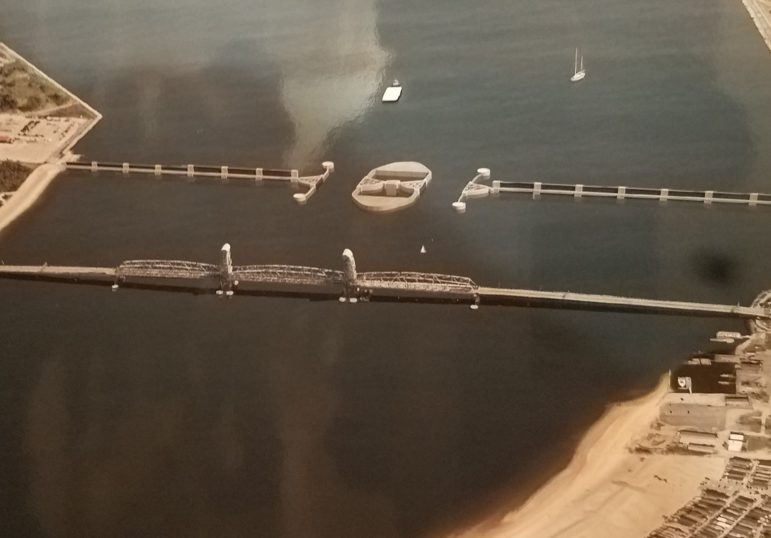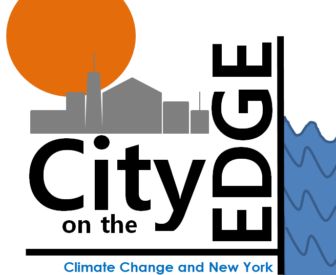
USACE
A very preliminary artist's rendering of what the surge barrier at the mouth of Jamaica Bay could look like.
Sometime in the summer of 2022, as the New York City area approaches the 10th anniversary of the death and destruction wrought by Superstorm Sandy, there will be a final proposal for a plan to protect the region’s coastline from the risk of catastrophic weather, a threat that will rise as climate change elevates global sea levels.
Depending on the course of action that the U.S. Army Corps of Engineers and governments on both sides of the Hudson agree on, it could be another nine years before their chosen defenses—maybe levees, floodwalls, tidal gates—are actually in place.
Relatively speaking, that’s the quick-fix option: The most ambitious plan on the table, which calls for the construction of a surge barrier covering the five miles of sea between Sandy Hook, N.J., and Breezy Point in Queens—could take a quarter century to complete.
A briefing on its recent interim report about coastal defense options by the Corps in White Plains on Tuesday night highlighted the breathtaking scale of the task the confronts policymakers and planners.
The timeline is long. The projects are complex. The estimated price-tags are massive, and likely understated. And the list of questions the Corps will have to answer is immense, covering everything from how surge barriers will affect tides and marine life and navigation to how the system can be designed to avoid exposing new areas to flooding danger.
The scale of the task reflects the scope of threat confronting the region. Each of the five potential protection strategies identified by the Corps would avoid billions—in most cases, tens of billions—of dollars in projected storm damage. That merely underscores how much destruction is possible in storms of the future, according to Bryce Wisemiller, a Corps project manager.
“The takeaway from that is there is a large coastal storm risk in this area. People need to be aware of that. The next storm will not by Hurricane Sandy. It could be worse,” Wisemiller said of the area involved in the current study, which is the size of Delaware. “The coastal storm risks are so dire and severe.”
The Tuesday night briefing was the first of eight the Corps has planned over the next several weeks. The next one is Wednesday night in Brooklyn. (A full list is below).
According to the Corps, those briefings will inform a draft recommendation for which alternative to pursue in early 2020, followed by an environmental review in 2021 and a final recommendation from the Corps to Congress in the summer of 2022.
Everyone from Bloomberg administration officials to environmental justice advocates have raised doubts about the efficacy of massive storm barriers. Some worry that it devotes too much money to just one threat from climate change. Others are concerned about the impact on coastal communities and wetlands.
Corps officials on Tuesday said resident comments would play an important role in identifying which storm risks and potential environmental effects are most critical to study. The previous round of study by the Corps generated 4,250 comments that contained 393 unique questions on everything from how the plan will address not just massive storms but also everyday flooding to how it will affect the shifting of sediments, the travel of ships and the costs of maintenance.
Estimates of how effective the proposed measures might be are limited in two key ways, officials said. One is that projections of how much sea levels will rise by the year 2100 are, by the very nature of the problem, uncertain; the Corps uses a mid-range estimate of about 18 inches but some scarier estimates predict multiple feet of rise.
Another is that the Corps’ go-to method for estimating the value of a protective measure, called HEC-FDA, is good at tallying up the potential replacement cost of property damaged or destroyed by a storm but not equipped to value the real-world importance of critical infrastructure, social vulnerability and other key factors. That is why the corps is experimenting with other measures.
So far, the results from each index track closely to the other, Wisemiller said. But that could change as the Corps gathers more information, and the nature of the coastal threat becomes clearer.
The upcoming meetings:
Wednesday, March 13th, 5:30-7:30 p.m. South Shore Educational Complex (Auditorium), 6565 Flatlands Avenue, Brooklyn, N.Y.
Tuesday, March 19th, 5-7 p.m. Snug Harbor Cultural Center, 1000 Richmond Terrace, Staten Island, N.Y.
Wednesday, March 27th, 5-7 p.m. Middletown Arts Center, 36 Church St., Middletown, N.J.
Wednesday, April 3rd, 5-7 p.m. at the Hudson Valley Community Center, 110 Grand Avenue, Poughkeepsie, N.Y.
Tuesday, April 9th, 5-7 p.m. Location: Alexander Hamilton U.S. Custom House, 1 Bowling Green, New York, N.Y.
Thursday, April 11th, 5-7 p.m. at the Meadowlands Environment Center’s first-floor auditorium, 2 DeKorte Park Plaza, Lyndhurst, N.J.
Wednesday, April 17th, 5-7 p.m. at the Hostos Community College, D Building/Savoy Manor Building, 120 East 149th St, 2nd Floor, Bronx, N.Y.
Get the best of City Limits news in your inbox.
Select any of our free weekly newsletters and stay informed on the latest policy-focused, independent news.










One thought on “Billions in Costs, Decades of Work, Dozens of Questions: Scope of NY’s Coastal Defense Project Reflects the Scale of Local Risks”
Any action that reduces the breadth of spread of a storm surge increases its height. Taxpayer funds would be better spent buying the property of residents and businesses and returning it to natural forces, and natural uses, with no expensive infrastructure to maintain or replace. Such a course of action eliminates the ‘costs’ of a storm, but, of course, may not be the most equitable for either those who must leave their homes or businesses or those who would foot the bill to buy them out. Freedom, personal liberty and responsibility, quality of life and more might be the greatest casualties of this or the COE plans.